Having difficulties remembering large passages of information?
We can take a CHUNK out of that!
Most people, like you and I, have limits to our memory!
-
But memory techniques – like CHUNKING – can help us stretch and overcome these natural limitations in our memory.
-
Because of this, chunking is a powerful memory trick that we can use to learn new information and keep it in our memories.
-
There are several ways that you can apply chunking in your everyday life – whether at work, at school, or even in your own leisure time.
-
You may even be familiar with some of the strategies we’ll be exploring below, and others will of course, be new.
The common line between them though?
– they will make your life much easier in terms of remembering and learning new information, especially if there is a lot to learn!
So, what is CHUNKING? And what is a chunk?
To answer that, we first need to go back to George Miller, the man who coined ‘The Magic Number Seven’
MILLER'S MAGIC SEVEN (plus or minus two)
- George A. Miller was a professor of psychology at Harvard University, who was interested in exploring he limits of short-term memory.
- In his research, he discovered that the number of discrete pieces of information we can remember at any one time – is seven.
- The information can include words, numbers, locations, or anything else you can think of.
- While most people average remembering 5-6 units of information, we cannot hold more than 8-9 units at most (hence the plus or minus two).
- The lucky number 7 then, is the most commonly-observed number of informational units that a person can retain in their short-term memory. So much so, that it came to be known as “Miller’s Magic Number Seven (plus or minus two)”.
So, if we know that seven is the general limit, then CHUNKING is our hack to get around it!
What is CHUNKING? How does it work?
You may have already read a bit about chunking in our first Memory Hack article, but for those of you who are unfamiliar – keep reading below to learn more.
Chunking is defined as the process of dividing large pieces of information into smaller units – or chunks. This makes it easier to store the information in our short-term memory. Essentially, one small chunk of information represents other items of information that carry more detail. You can liken this to the way that our computers or smart devices compress images or videos to take up less space in our device’s memory.
LET’S TRY AN EXAMPLE:

If you were asked to remember these letters off the bat, could you do it?
Give it a try: Read out the letters, then cover them up and see how many you can recall (the order is less important).
Not so easy right?
Let’s try it again using some chunking techniques:
Below are the exact same letters, but the order has been reversed. The letter have also been grouped into 3-letter strings. If you wanted to, you could even categorize the letters by theme (e.g. vowel, consonants, animals).
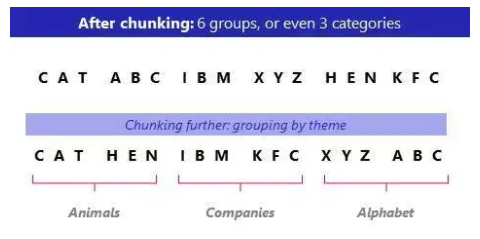
As we can see from this example, by using chunking, we’ve already made it easier to remember these seemingly random letters. Rather than trying to recall 18 individual letters, and 18 separate pieces of information, we’ve now reduced it down to just 3 pieces of information: animals, companies and alphabet.
Isn’t that much easier to remember?
Scientific research has shown how chunking can be used to help learn information faster and easier in all kinds of scenarios:
- Learning locations or positions of things
- Reading and learning music
- Learning words and letters
- Memorizing strings of numbers
Evidence also suggests that our sensory systems automatically “chunk” the things we see and hear, for example, so that we can process the environment around us faster and more easily, without even being conscious of it!
Think of chess players… do you think they spend their time analyzing each individual piece on the board and all of the possible moves for that one piece? Think again! They likely use chunking techniques to identify common patterns in moves, that allow them to process the whole board more quickly and easily.
You probably use chunking in your day-to-day lives without even realizing it. Mobile devices aside, think of the last time you had to memorize a phone number.
E.g. 4165551234
Some people may chunk this number in pairs:
41 65 55 12 34
Others may go the conventional route and divide them into groups of three, three, and four:
416 555 1234
How do you group the digits of a phone number? TRY it with your own phone number.
Group the digits in different arrangements (like above), say them out loud, and see if one way feels more familiar than another. Does either one feel like an alien number, even though it’s been your own number for so long?
THAT is the power of chunking!
CHUNKING TECHNIQUES
This is a popular strategy to use for improving your memory recall. Have you ever had to learn the names of the Great Lakes of North America?
Then maybe you have seen this acronym before: HOMES
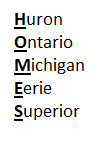
The first letter of the name of each lake spell the word HOMES.
If you can remember the acronym, you will likely remember the names of the lakes, because this form of chunking simplifies FIVE separate words into just ONE (although you still need to remember what each letter stands for).
For other examples, see Memory Hack under ACRONYMS.
While similar to acronyms, acrostics use the first letter of each word to create a new and memorable phrase.
Rather than the ‘homes’ acronym we used above to remember the names of the Great Lakes, we could create a phrase like:
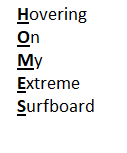
This acrostic has a double advantage, because it uses water-related imagery in keeping with the “lakes” theme. It also adds a little ‘crazy’, and therefore memorable image of a floating surfboard.
For other examples, see Memory Hack.
In your own practice, you may find that acronyms are easier to use than acrostics because when it comes time to recall the information, “decoding” an acronym takes one less step to remember.
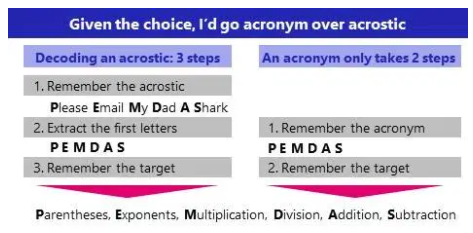
This strategy is premised on making lists easier to remember through the use of chunking.
What does that look like? Let’s think about our grocery list when we head out to the store.
Remembering two items (such as “pancakes and hotdogs”) is much easier than trying to remember twelve (flour, eggs, milk, syrup, lemon, buns, sausages, relish, mustard, ketchup, hot peppers, fries).
Even if you remember the recipes for each item you want to make, adding a little structure to your shopping list by grouping them together in categories can make it much easier to remember!
The example below shows you what an un-chunked shopping list looks like, and how much easier it can be to read and remember when you are looking at a grocery list that has been organized into chunks:
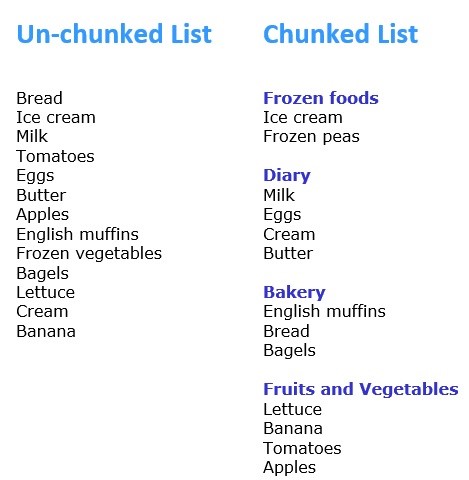
Successful categories rely on making appropriate associations and the level of meaning each item has for you.
See the example below for some inspiration on how to categorize your next shopping list.

The chunking technique is not only useful for to-do or grocery lists… it can also be applied to processes.
Take painting for example. You have a plan to spend the day painting your bedroom. How can we chunk this process you ask? Well let’s think of it in 3 parts (or chunks):
Chunk 1: Preparation
Chunk 2: Painting
Chunk 3: Clean-up
Now we can categorize the activities associated with each chunk:
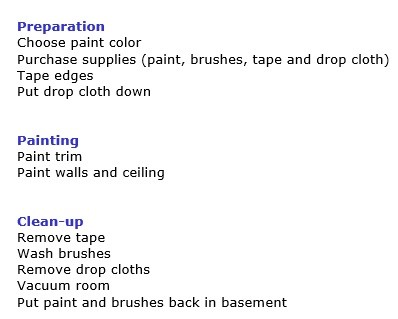
So what about when you’re reading a passage of text (long or short) and are having trouble remembering the information you’re looking at?
Chunking can also be used to simplify text and make it easier to remember key parts or details. When applied to reading material, chunking can be an effective way to break down difficult information into smaller, more manageable ‘bites’.
This technique is especially useful for identifying key words or ideas, and it can help foster your ability to paraphrase – something we do in written and spoken language all the time! Using the chunking technique can also be helpful when we want to organize and blend information from multiple or different sources.
See the steps below to better understand how to use chunking with text materials:

Need smaller steps? Try these variations below once you have selected your passage of text:
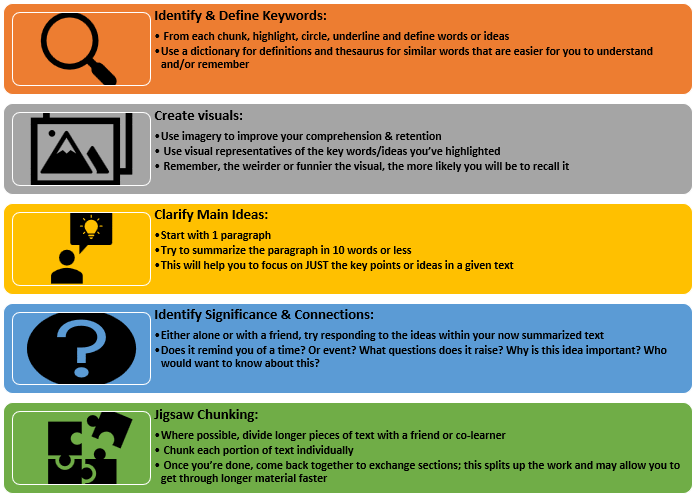
Nelson Cowan. (2005). Working Memory Capacity. Psychology Press.
The Peak Performance Centre. (2016). Chunking strategy – chunking information as a learning strategy. https://thepeakperformancecenter.com/educational-learning/thinking/chunking/chunking-as-a-learning-strategy/
Wadsworth, W. (2020). What is chunking and how to use it to boost memory. Exam Study Expert. https://examstudyexpert.com/chunking-and-memory/
Last Update: February 2021
